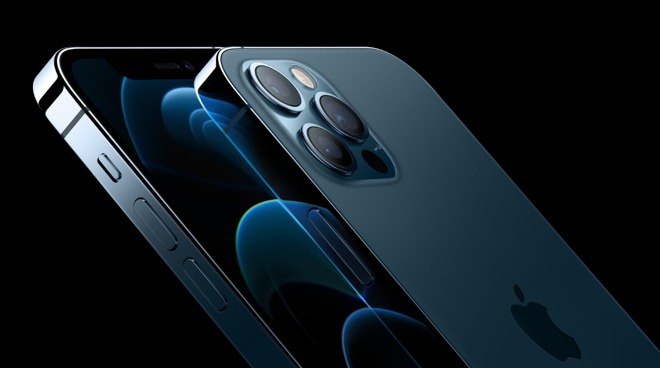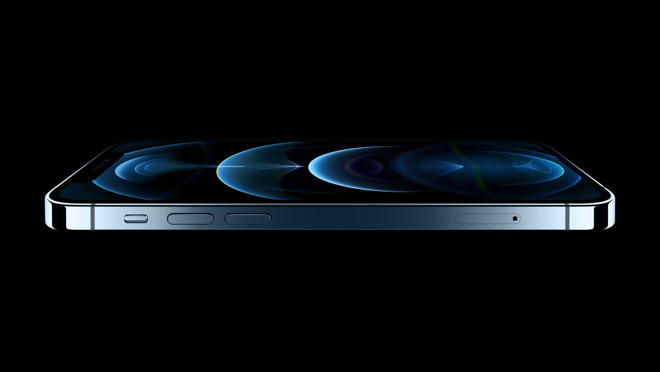Apple has unveiled its iPhone 12 Pro, the higher-tier model of 2020's iPhone range refresh that offers three cameras on the back, better displays, and LiDAR.

iPhone 12 Pro Max
Launched during Apple's "Hi, Speed" special event on Tuesday, the iPhone 12 Pro is the premium model of Apple's iPhone 12. Sharing the same core features as the iPhone 12 and iPhone 12 mini, the Pro models enhance what is offered to give a better overall experience to customers willing to pay more.
The iPhone 12 Pro uses a flat edge design that makes them similar to an iPad Pro. The Pro lineup is also where you'll find the largest iPhone display, with the iPhone 12 Pro equipped with an OLED Super Retina XDR 6.1-inch 2,532-by-1,170 display and the iPhone 12 Pro Max opting for an even larger 6.7-inch 2,778-by-1,284 version.
For 2020, Apple has also ensured the Pro models have superior video quality, with the inclusion of support for 10-bit color depth imagery in HDR video. The wide-color P3 screens also boast a 2 million to 1 contrast ratio, 800 nits maximum brightness, 1,200 nits of max brightness for HDR, and TrueTone support.

iPhone 12 Pro
Powering the iPhone 12 Pro line is the A14 Bionic System-on-Chip, which Apple revealed in the fourth-generation iPad Air. Packing in 11.8 billion transistors, it uses a new 6-core CPU and 4-core graphics architecture to make it 50% faster than any other smartphone chip available in both processing and graphical performance.
The chip also benefits from a new 16-core Neural Engine, which is twice as fast as the previous version and capable of up to 11 trillion operations per second. New second-generation machine learning accelerators in the CPU also means it will be 10 times faster for machine learning calculations.
Arguably the biggest draw for the iPhone 12 Pro lineup is its support for 5G cellular networks, which carriers are deploying in countries around the world. Furthermore, with support for mmWave -- at least in the U.S. -- it will also mean the iPhone models will be able to connect at the highest speeds 5G offers where mmWave is deployed, typically in built-up areas with higher populations.
Around back, Apple has gone with the same camera arrangement as in 2019, with three 12-megapixel cameras covering Ultra Wide, Wide, and Telephoto ranges, with a 4x optical zoom in, 2x optical zoom out, and a 10x digital zoom in. Equipped with dual optical image stabilization, it has Portrait Mode and Portrait Lighting effects, a Night mode, Smart HDR, and Panorama features.
On the Pro Max's wide lens, optical image stabilization has been upgraded to a DSLR-style Sensor Shift, where the sensor moves but the lens does not, enabling the image to stay sharper, and for longer exposures to be made that capture more light, even up to two seconds long when hand-held. All OIS motors can adjust up to 5,000 times per second, approximately five times as many adjustments than similar systems used in the iPhone 11 Pro range.
The iPhone 12 Pro's Camera app
Apple also took the opportunity to introduce Apple ProRAW for its Pro line, a new imaging format combining RAW photography with computational photography features like Deep Fusion and Smart HDR. This includes having full control over color, details, and dynamic range, all from the iPhone's Camera app.
Video has been boosted to include the ability to record in 10-bit HDR, and is the first to record in Dolby Vision HDR, something that can even be edited on the iPhone and even played through a compatible screen over AirPlay. It is able to do this even at 4K resolution at 60fps, as well as supporting 1080p slo-mo at 240fps, records stereo audio, and supports Audio Zoom.
At the top of the screen is the standard notch and TrueDepth camera array, which can capture 12-megapixel images complete with Portrait Mode and Portrait Lighting effects, 4K video recording at up to 60fps with cinematic video stabilization, 4k 30fps HDR with Dolby Vision, and 1080p slo-mo video at 120fps.
iPhone 12 Pro LiDAR
New for 2020, the iPhone 12 Pro and Pro Max are also equipped with a LiDAR sensor, which can perform time-of-flight calculations to generate a 3D map of the surrounding area.
Using the new sensor, users can take advantage of the depth data to create enhanced Portrait Mode imagery, among other photographic effects. It is able to assist the autofocus in low-light situation, making it gain focus 6 times faster.
It is also likely to have serious utility for ARKit applications that can use the added depth data, including room scanning.
The iPhone 12 Pro and iPhone 12 Pro Max
The water resistance has been updated again this year, with the models rated for IP68 splash, water, and dust resistance, enabling it to survive 6 meters of submergence for up to 30 minutes. Support for MagSafe is also included, enabling it to work with the new line of cases and accessories, and to line up correctly on supported wireless chargers.
In terms of other wireless, the pair also include Wi-Fi 6 support with MIMO, Bluetooth 5.0, and Ultra Wideband, which is used for spatial awareness in features like AirDrop.
Battery life is rated at up to 17 hours of video playback for the Pro, and up to 20 hours on the Pro Max. Supporting up to 15W of wireless charging using MagSafe chargers, it can also take advantage of wired charging for fast-charge, reaching 50% battery life in around 30 minutes with a 20W adapter or higher.
The iPhone 12 Pro starts from $999 with a higher starting capacity of 128GB, $1,099 with 256GB of storage, and $1,299 for 512GB. Meanwhile the iPhone 12 Pro Max starts from $1,099 for 128GB, rising to $1,199 for 256GB, then $1,399 for 512GB.
The iPhone 12 Pro will be available to preorder from Oct. 16, with shipping starting from Oct. 23, while the Pro Max preorders start from Nov. 6 with shipments starting Nov. 13.
